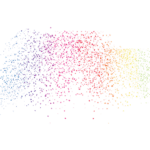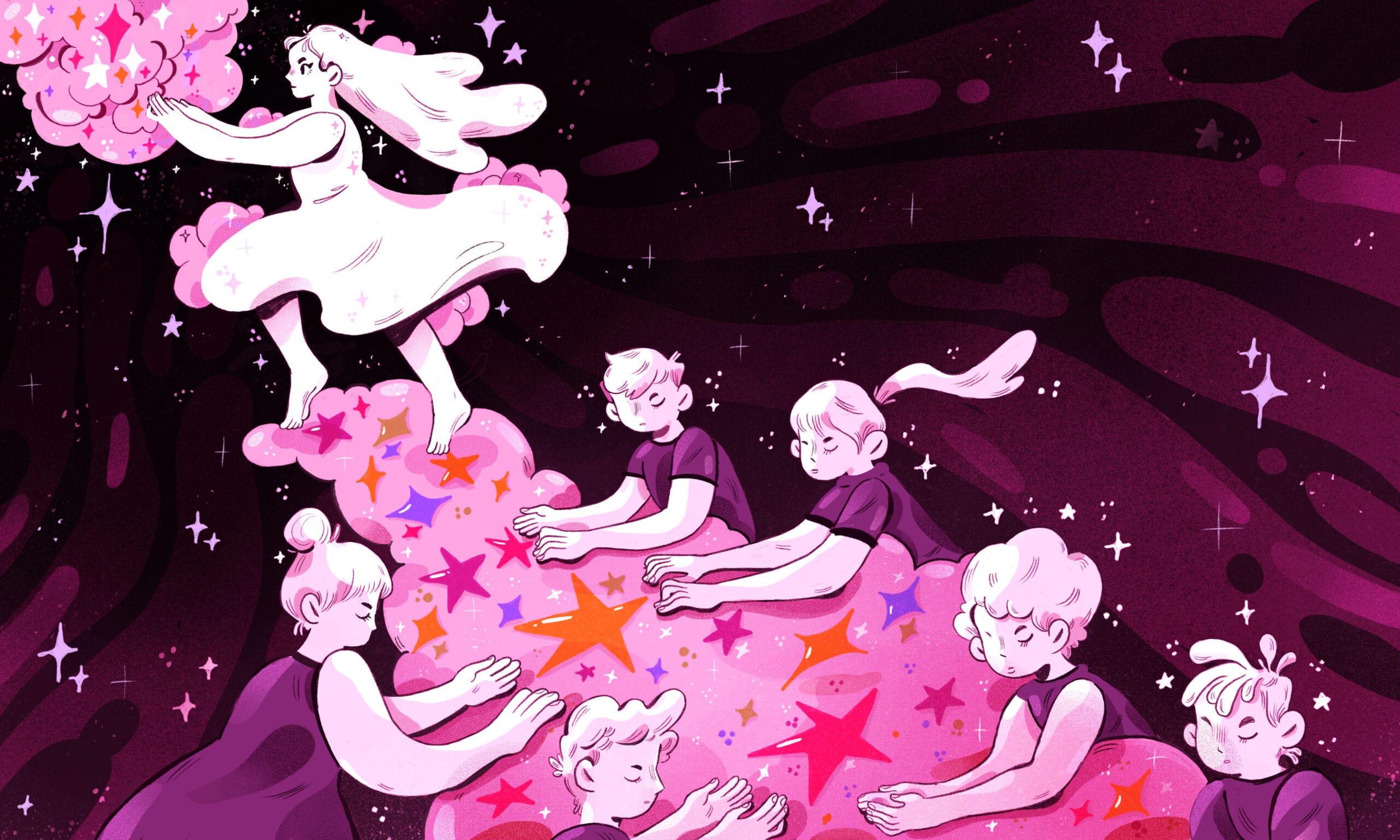The morning my mom died, a nurse called to tell me the news and asked me to come to the hospital. I thought she needed me to sign some paperwork.
I’d never lost a close family member before so I didn’t know what to expect: I was a queer person in my mid-30s, the only child of a single mother navigating through death’s unfamiliar territory without a map to guide me. When I got to the hospital, the nurse ushered me into my mother’s hospital room where I was unprepared to be alone with her body. She’d been sick for six years and I knew she was going to die, but I still wasn’t ready to see her small, still frame under a blanket. I remember feeling conflicted as I stood at my mother’s bedside. Part of me wanted to find sacredness and connection in that final moment with her. The other part of me wanted to get out of there as fast as possible because the experience felt like more than I was capable of holding alone.
It was the one time in my life I wanted so badly to be part of a religious community, to be rooted in a tradition and set of practices that would tell me what to do when someone dies. I wanted a community of older, wiser adults with shared values to swoop in and help me through the process: This is how we wash the body, this is what we do with the body, this is how we say goodbye, this is how we mourn. I wanted to be held and I wanted something to hold on to. I felt unmoored by death; I needed a sturdy container where I could let my grief run wild and I imagined that being part of a religious community might feel that way.
What I had instead was queerness and the do-it-yourself mindset I’d learned from the queer community. Queerness gave me the tools I needed to build my own container for the grief I felt losing my mom.

There’s something inherently creative about being queer—that’s why it’s a noun and a verb. We’re adept at the work of imagination, transformation and creation. We defy norms and stereotypes throughout our lives as we make and remake our identities, families and communities to reflect the visions we hold for ourselves and how we want to live. I brought this spirit into the experience of losing my mom.
Although she didn’t share my queer identity, I think she would’ve appreciated the spirit I brought to her death. My mom was an artist, a writer and a survivor who spent decades doing grassroots activism out of her kitchen, in art galleries, community spaces and in the streets. Much of her work centred on documenting and fighting against individual and structural violence against women and children. My relationship with my mom was complex and imperfect but we loved each other fiercely, and she was the first person to teach me about community healing and systemic transformation through art and activism.
When my mom died, I felt like an orphan. My grief was an unruly, ever-shifting mix of emotions that would leave me unexpectedly crying on the bus, zoning out by binge-watching episodes of Call the Midwife or channeling the overwhelmingness into frantically making spreadsheets to track the endless to-do lists that come with death. I needed something to help me move through the grieving process, and since I didn’t have a faith tradition or knowledge of my ancestral practices to guide me, I did something the queer community is so good at: I did it myself. I created my own personal grief rituals, small ceremonies that helped me find healing and meaning through death.
The day my mom died, I gathered a group of her close friends on the bank of a creek she held sacred, where we stood knee-deep in snow and laughed, cried and shared our memories of her. In those raw early hours of my grief, it helped to be with other people who were also mourning my mom in a ritual of remembrance, something I’d first learned to do from other queer folks while mourning the deaths of LGBTQ2 people in our community.
“Queerness gave me the tools I needed to build my own container for the grief I felt losing my mom.”
Paying a funeral home to organize my mom’s memorial felt too formal, not to mention expensive. I didn’t trust that they would be queer-competent enough to work with me and I felt afraid of getting boxed into a staid traditional memorial that didn’t reflect my mom’s activist spirit. So, a couple of months later, I used the skills I’d developed from years of organizing and hosting queer dance parties and cabarets to help plan my mom’s memorial service. I figured organizing and emceeing a memorial service wasn’t all that different from the queer cabarets I’d organized before—except without the burlesque performers and drag queens.
It was death, DIY queer style.
Both my experience with my mom’s death and my own work as an LGBTQ2 health advocate have me wondering what it would look like to queer death, and what queering death might offer the LGBTQ2 community as a means of individual and collective healing. What would have to change for us to die well, and for our loved ones to be held in their grief? How might creating or reclaiming our own personal and group rituals around death and dying help facilitate this change? How does all this fit into larger efforts to transform common beliefs and practices about death? And how is it connected to movements for social, economic and environmental justice?
I’m not alone in thinking about transforming death: There’s a whole death-positive movement made up of people both within and outside of the death and funeral industries who are working toward change and trying to open up the conversation about dying and death. It’s about confronting fear, shame, denial, silence and repressive cultural norms in the service of honouring people’s wishes and identities through all phases of their lives—including when we die. That seems like a pretty queer sentiment to me!
Different cultures, faith communities and groups have their own beliefs and practices around dying, death and grief. My experience growing up as a non-religious white settler in Canada meant I’d internalized a death-avoidant culture. We deny death, we don’t talk about it and we’re only allowed to grieve if we follow an ableist, capitalist script: Be sad, but not too sad, don’t be too much or too messy and get back to normal as quickly as possible so you can be productive again. If I’d followed this limiting script, I wouldn’t have been able to grieve in a way that felt authentic or healing to me. It’s why I looked to queerness and the queer community for alternatives.

The LGBTQ2 community has a complex and intimate relationship with death. It’s a proximity rooted in the violent impacts of systemic oppression: LGBTQ2 people are at higher risk of suicidal ideation and suicide, a health disparity that has a disproportionate effect on the trans community. We’re the targets of violent hate crimes, which also disproportionately impact trans and gender-diverse people—especially trans women of colour and sex workers. We live with the past and present legacies of the HIV epidemic, which include massive loss of life and experiences of chronic bereavement among those who survived. In death, we and our loved ones may experience homophobia and/or transphobia from family members or funeral homes—a profit-motivated industry with an estimated worth of $1.6 billion in 2017 and $20 billion in the U.S. We might be denied the ability to care for and honour our dying and dead in ways that align with their values, identities and cultural practices, including being unable to afford the thousands of dollars needed to hold a funeral and pay for burial or cremation, costs that are prohibitively expensive for the many LGBTQ2 people living in poverty. These are all forms of systemic violence—a closing off of possibilities for ritual, remembrance and healing.
“The LGBTQ2 community has a complex and intimate relationship with death.”
But we have possibility models to learn from, too, and LGBTQ2 lineages to lean into. During the height of the AIDS epidemic, the partners of people who were dying held vigils and created their own rituals when their beloveds died. They washed, dressed and visited with their bodies, held ceremonies, built altars and organized their own memorials ranging from religious services to dances and parties. For over 20 years, people around the world have gathered annually to honour the Transgender Day of Remembrance, a community memorial that initially grew out of trans writer and activist Gwendolyn Ann Smith’s efforts to commemorate Rita Hester and Chanel Pickett, two Black trans women who were murdered in the 1990s. LGBTQ2 Latinx communities honour their queer and trans ancestors each November with altars and processions marking Dia de los Muertos, a tradition rooted in ancient Indigenous practices.
I think of people like Andrew Henderson (a.k.a. Glamdrew), a 28 year-old queer artist in Winnipeg who was diagnosed with incurable cancer and, in 2016, decided to co-create Taking it to the Grave, a performance that was both a living funeral and community ritual. Together with collaborators Eroca Nicols, Carly Boyce and Mars Gradiva, Glamdrew invited participants to dance on a glitter-bedecked dancefloor, give themselves manicures at a nail art station and—perhaps most powerfully—confess the secrets, regrets or baggage they wanted him to take to the grave.
“Queerness and queer community helped me find my way through death back then.”
Together, Glamdrew and each confessor would create an image that represented what the person wanted to let go of. Boyce would then tattoo that image on Glamdrew’s body so he could literally take it to the grave. I wasn’t able to attend this performance—I live thousands of kilometres away—but I still think about it years later because it offered me a vision into something I didn’t know was possible: A way to turn queer death into art and create space for personal and community healing.
Death is inevitable and being confronted with its reality can feel sad, scary or overwhelming. But there can be beauty and healing in it, too. When I think back to when my mom died, I still feel grief and regret that I wasn’t able to turn that final moment at her bedside into a ritual of connection and care for her. It felt impossible for me at the time, all alone in that hospital room with no one to help or guide me. Queerness and queer community helped me find my way through death back then. They offered me a path through my grief and into healing. Now, as I contemplate my own inevitable end, I find comfort and inspiration in knowing that I can queer my own death, too, and that it could be a final gift I offer to the beloved community I leave behind.


 Why you can trust Xtra
Why you can trust Xtra


